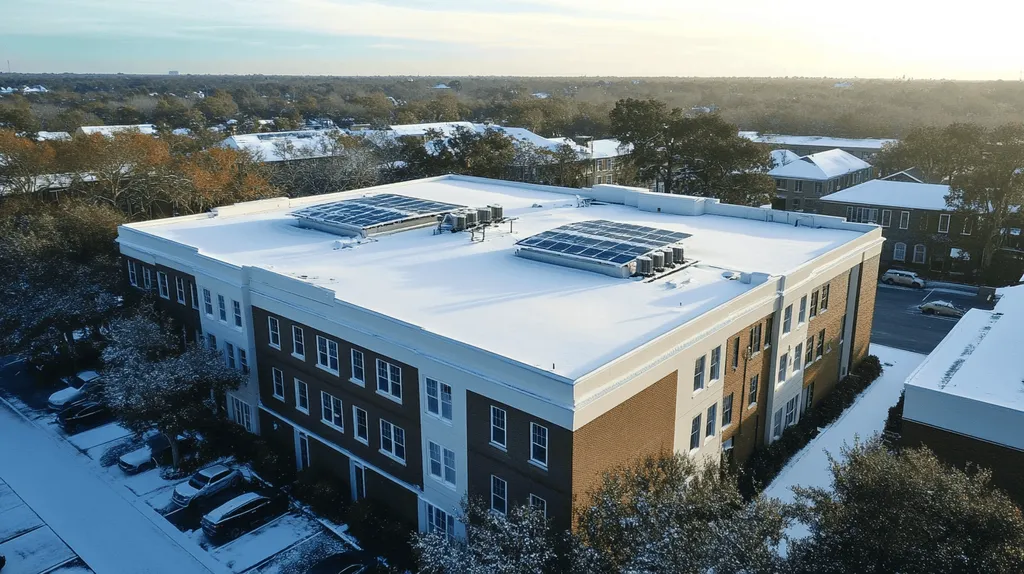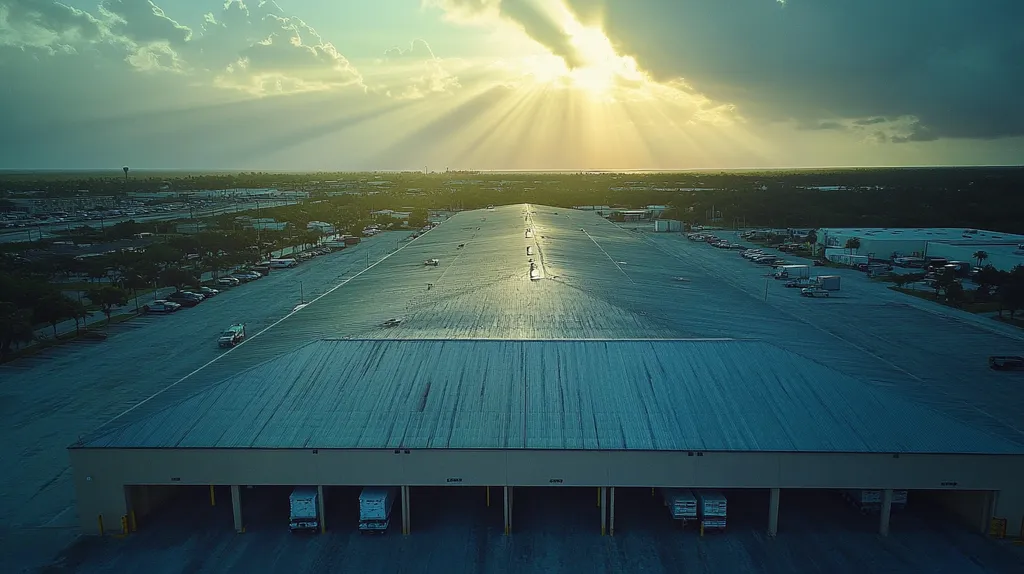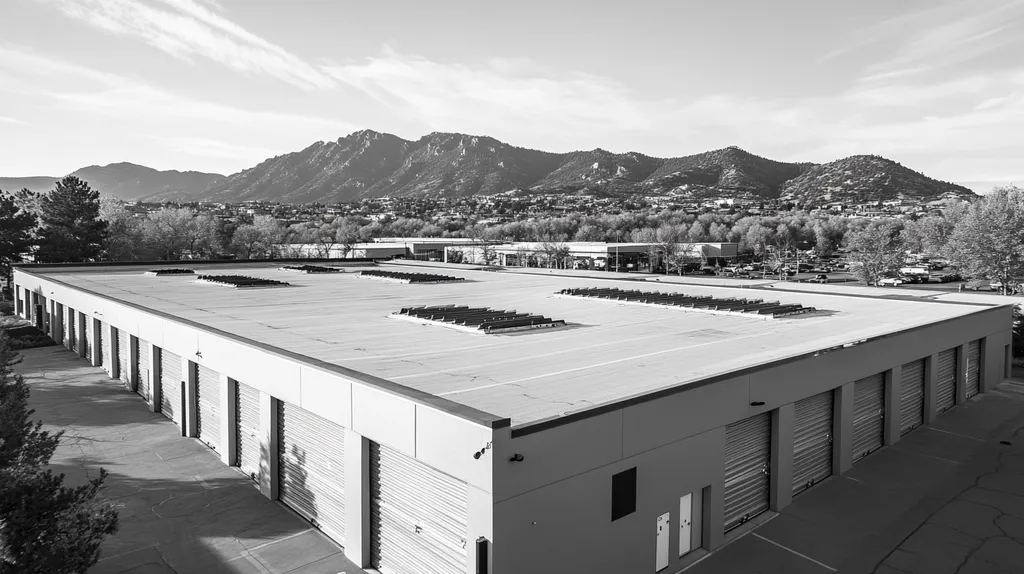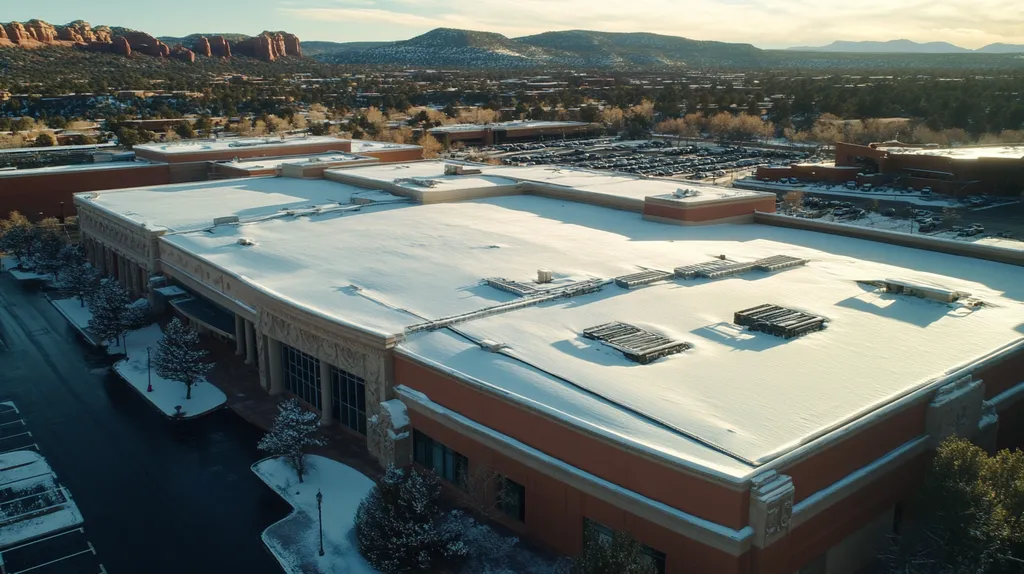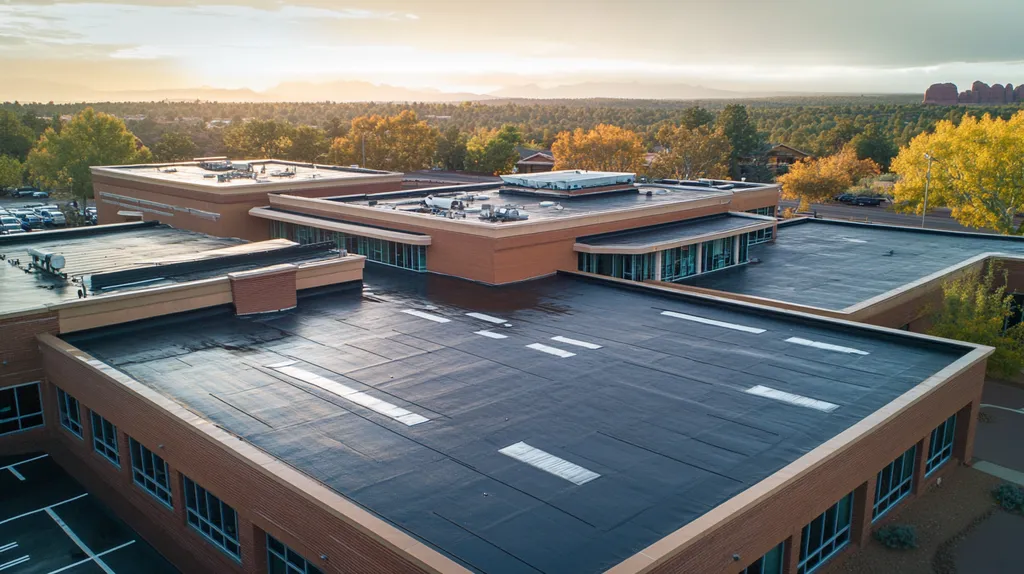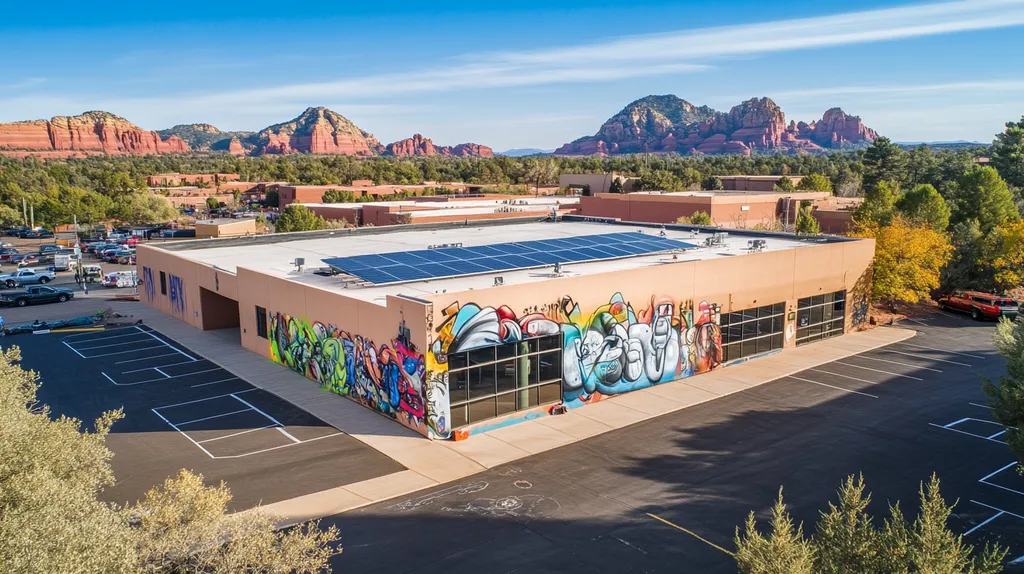The difference between a successful industrial roof coating and a costly failure often comes down to one critical factor: location. Studies show that up to 40% of premature roof coating failures stem from selecting products unsuitable for local environmental conditions.
From scorching desert heat to corrosive coastal environments, each location presents unique challenges that directly impact coating performance and longevity. Without proper assessment, facilities risk expensive repairs, increased energy costs, and potential regulatory violations.
This comprehensive guide examines how geographical and environmental factors influence coating selection through six key areas: performance factors, financial considerations, compliance requirements, risk management, operational procedures, and long-term planning.
SECTION 1: PERFORMANCE FACTORS
Selecting the appropriate coating for industrial roofs is a critical decision that can have lasting impacts. An unsuitable choice can lead to soaring energy bills and a drastically reduced roof lifespan. For instance, high temperatures can accelerate roof degradation, potentially costing facility managers thousands in unnecessary repairs. By understanding the performance factors involved, facility managers can make informed decisions that protect both their property and finances.
Roofing Material Compatibility
Not every coating is a perfect match for every roofing material. Ensuring compatibility between the existing roof and the chosen coating is essential for maximizing effectiveness. For instance, using a coating designed for metal roofs on a TPO surface can lead to adhesion problems and premature failures.
Facility managers need to consider how different materials expand and contract with temperature changes. This awareness helps prevent issues like water infiltration and leaks, which can escalate repair costs. Neglecting this compatibility can trigger expensive system breakdowns.
Additionally, certain materials may necessitate specialized primers or base coatings to ensure lasting adhesion and performance. Investing in the right coating not only extends the roof’s life but also reduces the ongoing maintenance burden. A thorough evaluation at the outset is essential.
Key Action Items
Weather Resistance and Durability
Industrial roofs face relentless outdoor conditions that can challenge their structural integrity and lifespan. Choosing coatings with strong weather resistance is vital. High-quality coatings can endure elements like UV rays, hail, and wind-driven rain, prolonging the roof’s life.
For facilities situated in areas with extreme temperature swings, it’s critical to select coatings that accommodate thermal movement. Failing to consider this can result in cracking or peeling, which undermines the roof’s protective capabilities and leads to costly issues.
Moreover, durable coatings can fend off damage from corrosive environments, such as those near saltwater or industrial emissions. Prioritizing durability not only ensures long-term roof performance but also reduces maintenance frequency. Selecting the right coating for the local climate can prevent repeat repairs.
Key Action Items
Energy Efficiency and Reflectivity
In today’s economic climate, energy efficiency has become a top concern for many facility managers seeking to cut costs. Roof coatings that prioritize high reflectivity can drastically decrease energy consumption by limiting heat absorption—a necessity in hotter regions where cooling expenses can skyrocket.
Coatings that effectively reflect sunlight can help maintain cooler building interiors, reducing the need for air conditioning. This not only lowers energy bills but also enhances occupant comfort and satisfaction.
In addition, some energy-efficient coatings qualify for utility rebates and incentives, making them financially appealing. By choosing these coatings, facility managers may find that their savings can offset the initial installation costs. Such options align with sustainability goals, enhancing the facility’s appeal to environmentally-conscious clients (source: Trust Tillotson).
Key Action Items
SECTION 2: FINANCIAL CONSIDERATIONS
Selecting the right coating for industrial roofs involves managing high stakes, as the wrong decision can lead to escalating costs over time. Research indicates that ineffective coatings can increase energy bills by up to 20% and accelerate the deterioration of roofing materials. Understanding these financial implications is essential for facility managers to optimize their roofing budgets.
Initial Cost and Budget Constraints
The initial investment in roof coatings can vary widely based on location and the type of coating selected. Reflective coatings, for instance, may come with a higher upfront price tag but will typically provide significant long-term savings through energy efficiency. Facility managers need to assess their budget while taking into account the specific needs of their roofing system.
Local regulations can also impact these initial costs. In areas with stringent environmental policies, opting for compliant products, which may be more costly, becomes essential. Neglecting these requirements can result in unexpected expenses that strain budgets.
Conducting a thorough cost analysis before making a coating choice is crucial. By comparing quotes and evaluating the overall expenses throughout the roof’s lifespan, hidden costs often become clear. Prioritizing quality may lead to substantial savings on maintenance and repairs in the long run.
Key Action Items
Long-Term Maintenance and Recoating Costs
The impact of maintenance costs on overall roof coating finances can be significant. Some products require frequent inspections and updates, while others are designed for longer intervals between maintenance services. Evaluating these differences is essential to avoid escalating expenses in the future.
For example, certain elastomeric coatings may require recoating every five years, while durable options may offer ten years or more of reliable performance. Selecting the most suitable coating can extend service life and reduce future costs.
Including labor and material costs for routine maintenance in financial planning is vital. A robust preventive maintenance plan can lead to even greater savings by identifying issues early and avoiding the need for costly emergency repairs.
Key Action Items
Energy Savings and ROI Analysis
Energy efficiency serves as a critical financial consideration in coating selection. Reflective coatings can cut cooling costs by as much as 30% in warmer climates, making it essential for facility managers to assess how local climate affects their energy needs.
Calculating return on investment (ROI) requires evaluating both potential energy savings and available tax incentives. Many states provide rebates for energy-efficient roof coatings, improving the financial outlook significantly.
Moreover, energy-efficient roofs can enhance sustainability goals, positively impacting a company’s reputation and possibly leading to increased business opportunities. A thorough ROI analysis equips facility managers to make informed choices that benefit both their budgets and the environment.
Key Action Items
SECTION 3: COMPLIANCE REQUIREMENTS
Navigating compliance requirements for industrial roofing coatings is critical for safeguarding investments and ensuring workplace safety. Non-compliance can lead to severe financial penalties and liability risks, as well as potential operational shutdowns. Facility managers must adeptly manage building codes, fire resistance regulations, and environmental standards to ensure that their coating choices fulfill all legal obligations.
Building Codes and Safety Standards
Building codes are crucial for maintaining safety as they differ from one locale to another. These regulations ensure that industrial roofs can endure the environmental pressures of wind and rain, preventing unsafe conditions. Failure to comply can result in costly remodeling and operational disruptions.
Facility managers should engage with local building authorities to clarify which codes apply to their roofs. Many regions provide guidelines on acceptable materials and installation methods, enabling proactive compliance that supports long-term roof performance.
Understanding and adhering to these codes can enhance the structural integrity of roofing and prevent safety hazards during adverse weather conditions. Non-compliance can also lead to increased insurance premiums or denied claims following a roof failure, making it vital for facility managers to prioritize compliance in their coating selection.
Key Action Items
Fire Resistance and Regulatory Compliance
Fire resistance is a vital compliance consideration for any facility, given the potential dangers presented by flammable materials. Using coatings that meet local fire codes is imperative. The National Fire Protection Association provides clear guidelines regarding fire ratings required for roofing materials.
Choosing a coating with the necessary fire resistance not only fulfills regulatory demands but significantly boosts workplace safety. Facilities plagued by fire incidents face not only operational delays but also serious legal ramifications and damage to their reputation.
Facility managers need to assess the fire performance classifications of potential coatings. Opting for higher-rated products, such as Class A coatings, enhances protection against fire risks. Additionally, proving compliance with fire safety standards may lead to lower insurance premiums.
Key Action Items
Environmental and Health Regulations
Environmental regulations play a growing role in roofing coating selection. Compliance with laws such as the Clean Air Act mandates using low-emission products to reduce air pollution. Facility managers should consider the environmental impact of their chosen coatings.
Coatings with high volatile organic compounds (VOCs) can adversely affect indoor air quality and employee health. Selecting low-VOC or zero-VOC options not only ensures legal compliance but also fosters a healthier work environment, which is crucial for employee well-being.
Life-cycle assessments are increasingly common in evaluating the environmental footprint of roofing materials. Facilities that align their coatings with sustainable practices may unlock tax incentives and grants, easing financial burdens while meeting environmental goals.
Key Action Items
SECTION 4: RISK MANAGEMENT
Effective risk management is crucial when selecting roofing coatings for industrial properties. With weather patterns becoming increasingly unpredictable, understanding climate-related risks is vital to prevent damage and costly repairs. For example, approximately 25% of roof failures are attributed to inadequate coating choices that ignore environmental factors. This section will explore essential assessments related to climate risks, UV exposure, and the effects of water ponding on roofing systems.
Climate and Environmental Risk Assessment
The local climate plays a pivotal role in determining the most suitable coating for an industrial facility. Extreme temperatures, heavy rainfall, and high winds can all impact the effectiveness and longevity of roofing materials. For example, facilities in regions with significant rainfall need coatings that effectively resist moisture to avoid leaks and structural integrity issues.
Additionally, facilities in storm-prone areas should opt for coatings that offer enhanced adhesion and flexibility to withstand potential wind uplift, thus preventing the roof from tearing. Ignoring these climatic factors can lead to substantial financial repercussions over time.
A comprehensive environmental risk assessment should incorporate localized weather data and historical weather trends. This enables the selection of coatings specifically designed to survive the unique challenges posed by the local climate, helping to ensure a roof that meets its intended lifespan.
Key Action Items
UV Radiation and Sunlight Exposure
Understanding UV radiation exposure is essential in coating selection since excessive sunlight can deteriorate roofing materials over time. High-reflectivity coatings, often known as “cool roofs,” can significantly extend the life of roofing systems by minimizing thermal expansion and contraction. Research indicates that reflective coatings can lower surface temperatures by as much as 50 degrees Fahrenheit.
UV-resistant coatings can protect against sun damage, enhancing the roof’s durability. Facilities in sun-drenched regions should prioritize these coatings to prevent deterioration and maintain structural integrity.
Failing to consider UV exposure can result in costly damage over time. Regular monitoring along with the application of suitable reflective coatings can alleviate these risks and enhance energy efficiency by lowering cooling costs.
Key Action Items
Water Ponding and Leak Resistance
Water ponding poses a significant risk to industrial roofs, particularly those with flat designs. Accumulated water can add excessive weight and potentially compromise the roof’s structure. Choosing coatings with high water resistance is essential for mitigating these concerns and extending roof longevity.
Coatings that effectively resist leaks prevent moisture infiltration, which can damage insulation and other internal structures. For facilities in rainy regions, addressing water ponding is critical to avoid expensive repairs and operational interruptions.
Best practices involve designing roof slopes for proper drainage and selecting coatings that have additives for enhanced water resistance. Conducting regular maintenance checks for areas prone to ponding will help identify issues before they escalate into more significant problems.
Key Action Items
SECTION 5: OPERATIONAL PROCEDURES
Choosing the right coating for an industrial roof is imperative for ensuring both long-term durability and cost savings. A poorly executed application can lead to premature failures, resulting in expensive repairs and operational interruptions. Inadequate preparation can even shorten a roof’s lifespan by up to 30%. Understanding the best application methods, surface requirements, and maintenance protocols is crucial for facility managers aiming for optimal performance.
Application Method and Installation Logistics
The method of applying industrial roof coatings significantly influences the outcome. Spray application offers uniform coverage but requires meticulous planning to prevent overspray and environmental hazards. On the other hand, roller application is easier to manage but may cause inconsistencies in thickness if not carefully monitored.
Logistical factors, such as weather, temperature, and humidity, are also essential considerations. Facility managers should schedule coating work during favorable weather conditions to ensure proper adhesion and drying times.
Engaging a qualified contractor with a detailed installation plan guarantees the correct methods are executed. This includes conducting pre-installation inspections and using suitable equipment to mitigate risks during the application process.
Key Action Items
Surface Preparation and Cleaning Requirements
Proper surface preparation is essential before applying any roof coating. Skipping this step can compromise adhesion and, therefore, the effectiveness of the entire roof system. Using suitable cleaning agents, like sodium hypochlorite or eco-friendly cleaners, helps eliminate dirt, mildew, and other contaminants.
The surface must be both dry and structurally sound prior to coating application. Conducting a water test can help identify moisture-prone areas that may lead to future issues. If the surface preparation is insufficient, no coating will perform optimally.
Additionally, clearing the roof of debris and loose materials enhances adhesion while promoting safety during application. Effective preparation not only extends the life of the coating but also minimizes future repair needs.
Key Action Items
Regular Maintenance and Inspection Protocols
Implementing a routine maintenance and inspection plan is vital for maximizing the lifespan of an industrial roof coating. Facility managers should establish a schedule to routinely check for signs of wear, such as bubbling, cracking, or discoloration. Ignoring these issues risks leaks and structural damages down the line.
Maintaining a record-keeping system for inspections will yield valuable insights over time. This practice aids in identifying trends and makes it easier to make informed decisions about necessary repairs or re-coating.
In addition to scheduled assessments, facility managers should monitor environmental conditions that could impact roof performance. Seasonal shifts can affect roof durability more rapidly than anticipated, leading to unforeseen maintenance needs.
Key Action Items
SECTION 5: OPERATIONAL PROCEDURES
Selecting the appropriate coating for an industrial roof is crucial for its long-lasting performance and financial viability. Poor application can lead to premature failure, resulting in unwelcome repair costs and interruptions in operations. In fact, inadequate preparation may reduce a roof’s lifespan by as much as 30%. Understanding the best application methods, surface preparation requirements, and maintenance protocols is essential for facility managers aiming for optimal results.
Application Method and Installation Logistics
The method chosen for applying industrial roof coatings is significant and can greatly impact the overall effectiveness. Spray application offers uniform coverage but requires precise planning to avoid overspray and environmental issues. In contrast, roller application is easier to manage but may result in inconsistent thickness if not monitored effectively.
Furthermore, logistical aspects such as weather, temperature, and humidity need to be considered, as they can significantly influence adhesion and drying times. Facility managers must schedule coating work during optimal weather conditions to maximize overall performance.
Hiring a qualified contractor with a solid installation approach ensures the correct methods are employed. This should encompass thorough pre-installation inspections, along with the use of appropriate equipment to mitigate any risks during the application process.
Key Action Items
Surface Preparation and Cleaning Requirements
Thorough surface preparation is critical before any roof coating is applied. Skipping this step can lead to adhesion failures, jeopardizing the entire roof system. Appropriate cleaning agents, such as sodium hypochlorite or eco-friendly cleaners, should be employed to eliminate dirt, mildew, and other contaminants.
The surface must also be both dry and structurally sound to ensure effective coating application. Conducting a water test can help identify moisture-prone areas that could pose future problems. If the surface is not adequately prepared, no coating will perform optimally.
Additionally, operators should clear the roof of debris and loose materials, which enhances adhesion and bolsters safety during application. Proper surface preparation can extend the life of the coating and reduce the need for repairs.
Key Action Items
Regular Maintenance and Inspection Protocols
Regular maintenance and inspections are vital to enhancing the longevity and effectiveness of industrial roof coatings. Facility managers should establish a routine inspection schedule to detect signs of wear, such as bubbling, cracking, or discoloration. Failing to address these issues can lead to leaks and serious structural damage.
Implementing a record-keeping system for these inspections offers valuable insights over time. This makes it easier to identify trends and make informed decisions regarding necessary repairs or re-coating.
Moreover, facility managers should actively monitor environmental factors affecting roof performance. Seasonal changes can rapidly influence a roof’s condition, resulting in unexpected maintenance needs.
Integrating these protocols into an overall facility management plan not only safeguards the investment in roof coating but also boosts the overall operational efficiency of the building.
Key Action Items
The Bottom Line
With 40% of premature roof coating failures stemming from poor location-based choices, facility managers cannot afford to overlook geographical factors when selecting industrial roof coatings.
Local climate conditions, environmental regulations, and economic factors all play crucial roles in determining coating success or failure.
From scorching desert environments to corrosive coastal regions, each location demands specific coating properties to ensure optimal performance and longevity.
By carefully evaluating performance factors, financial considerations, compliance requirements, risk management strategies, operational procedures, and long-term planning, facility managers can select coatings that protect their assets while maximizing return on investment.
The future of industrial roofing lies in location-specific solutions that balance durability, compliance, and cost-effectiveness.
FREQUENTLY ASKED QUESTIONS
Q. What factors affect commercial roof coating performance?
A. Several factors influence coating performance, including material compatibility, weather resistance, and climate conditions. High temperatures can accelerate degradation, while compatibility issues can lead to premature failures. Loss of effectiveness can result in higher maintenance costs and energy bills.
Q. How does coating selection impact industrial roof costs?
A. Selecting the wrong coating can lead to significant increases in energy and maintenance costs over time. A proper analysis of initial costs and long-term benefits is necessary to avoid overspending. Quality coatings often provide savings with proper maintenance.
Q. What compliance issues affect industrial roof coatings?
A. Compliance with local building codes, fire safety regulations, and environmental standards is crucial. Non-compliance can lead to penalties, operational disruptions, and safety risks. Always verify requirements before making coating selections to ensure that they meet legal obligations.
Q. How do climate risks affect industrial roof coatings?
A. Climate risks, such as extreme temperatures and heavy rainfall, can compromise coating effectiveness. Selecting coatings suited for local climate conditions, including moisture resistance and durability against winds, can mitigate these risks and prolong the roof’s lifespan.
Q. What are key factors for proper coating application?
A. The application method, weather conditions, and correct surface preparations are crucial. Engaging qualified professionals and following best practices ensure optimal adhesion and performance. Thorough inspections before application can identify potential problems early on to avoid future issues.
Q. How can I enhance the longevity of my industrial roof coating?
A. Implementing a rigorous maintenance and inspection schedule is key. Regular checks for wear and timely repairs can significantly extend the coating’s life. Additionally, tracking environmental factors and keeping records of inspections will help address issues proactively.
Q. What are the benefits of high-reflectivity coatings for industrial roofs?
A. High-reflectivity coatings help reduce heat absorption, leading to lower cooling costs and enhanced indoor comfort. In warmer climates, they can significantly cut energy bills and may qualify for various rebates, providing a strong return on investment over time.

